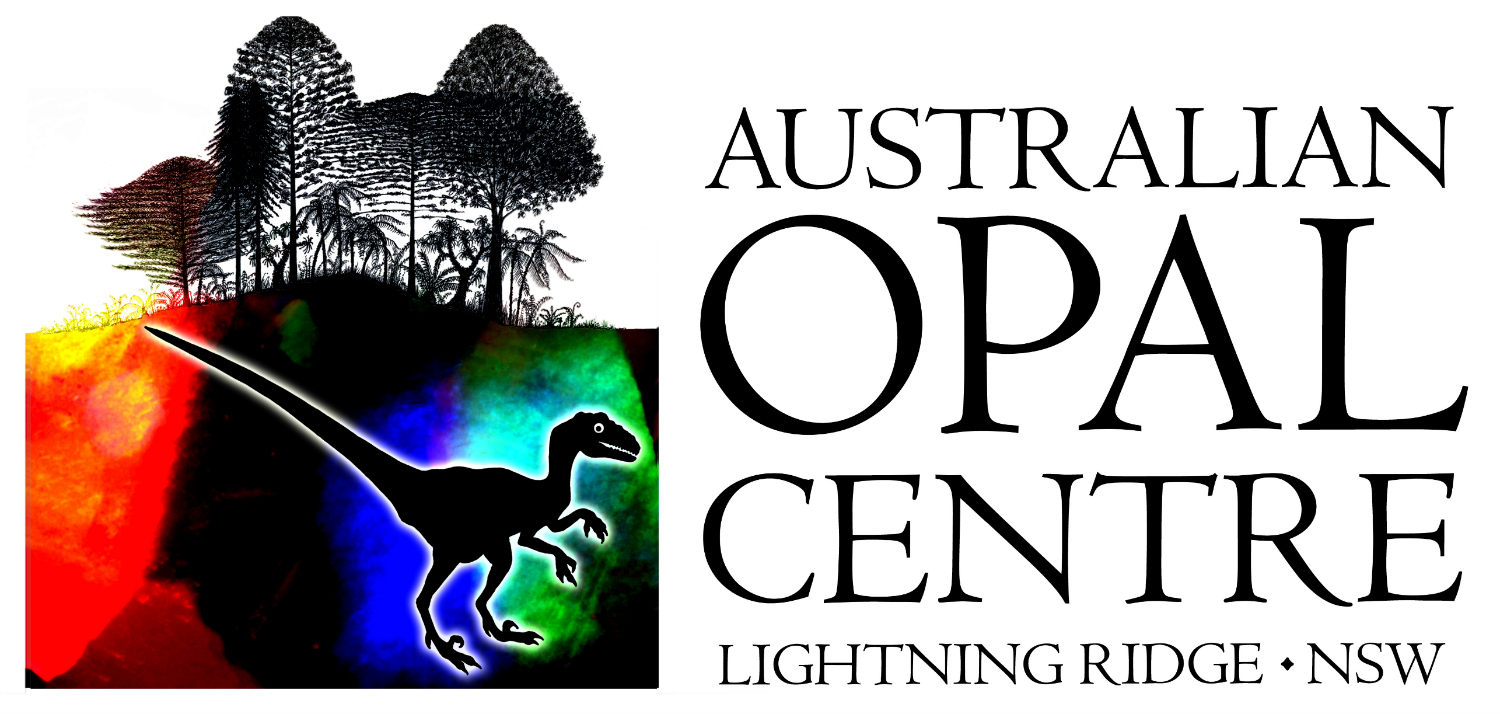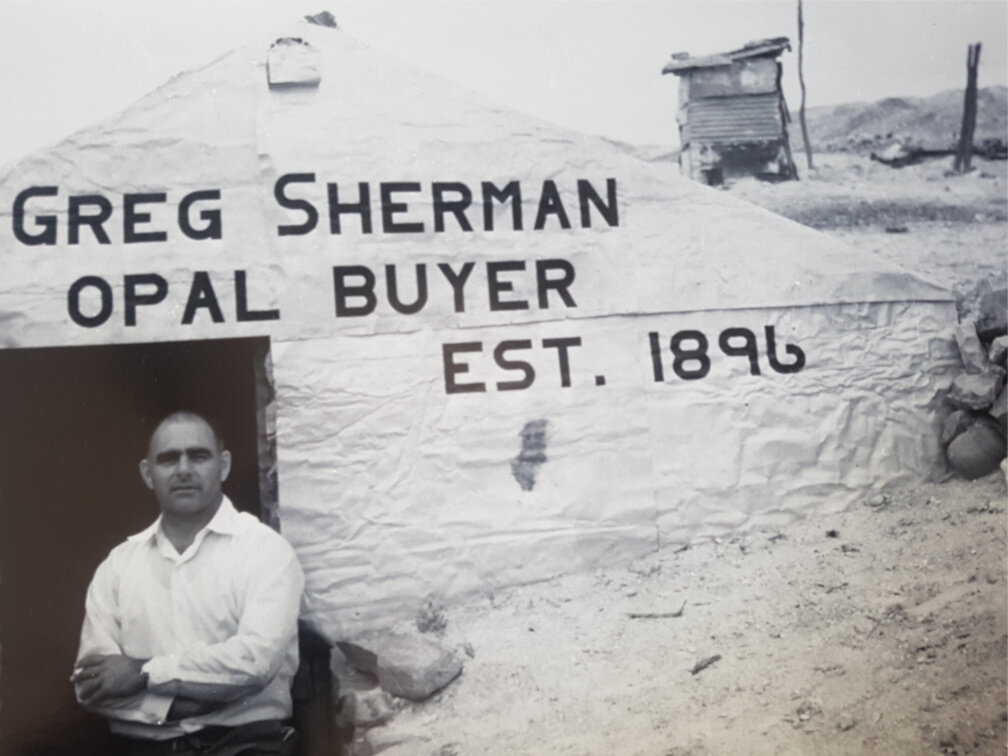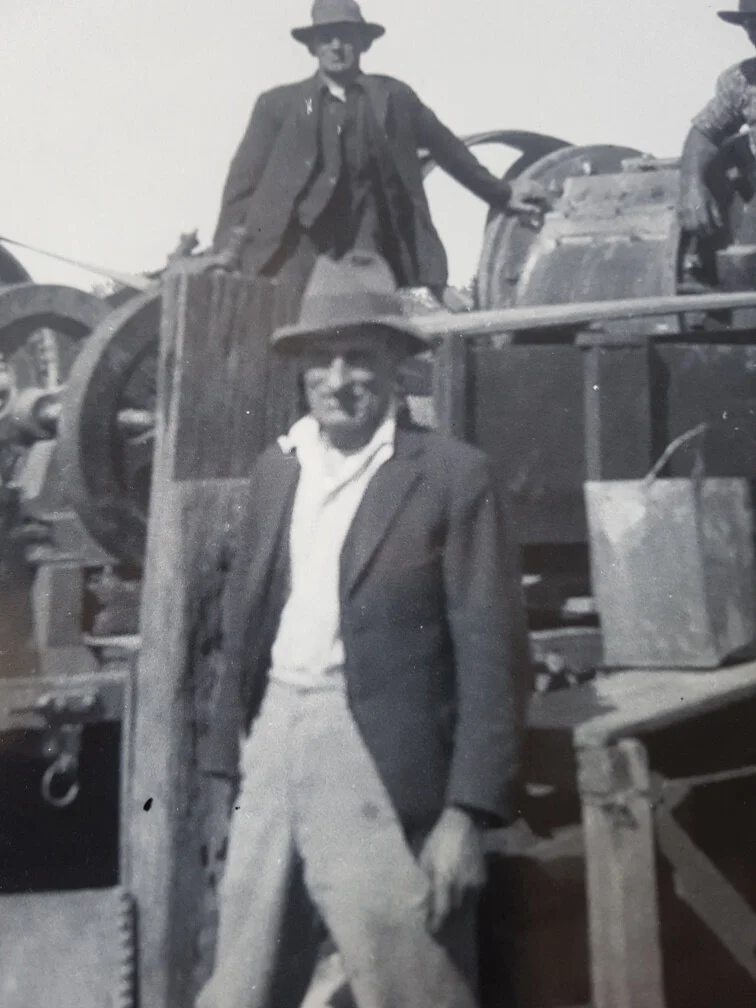““I see the Australian Opal Centre as a magnet for the future and a reflection of our past. I think it’s important to capture that past and show the future where you have been.””
Peter’s father Ernest Gregory Sherman Jnr
Peter’s grandfather and founder of Sherman Opals, Ernest Gregory Sherman
Peter Gregory Sherman
$20,000 AOC Founder
AOC Business Member
A third-generation Australian opal wholesaler and exporter, Peter Gregory Sherman has roots in the opal industry as far back as 1896 when his grandfather Ernest Gregory Sherman first set foot in White Cliffs, one of Australia’s earliest opal fields. A teenager when he was brought into the family business by father Ernest Gregory Sherman Jnr, Peter worked alongside his father, mother and brother Warwick until 1999 (when Warwick retired for other adventures), selling highly prized black and crystal Lightning Ridge opal around the world. Today he is the sole proprietor of Sherman Opals. Here, Peter recounts his time working in the opal industry, and explains why the preservation of his family’s history and heritage of the Australian opal industry has led him to become an AOC Founder.
“I first became involved in the opal industry when I was a teenager. I wanted to be an architect but my father became ill in 1967 when I was 15 and the great opal dealer Fred Giles told my mum to get me or my brother into the family business so it could continue. I worked in the office until I was 17, at the same time I was at school. My father and grandfather had good relationships with everyone, so blokes from all different walks of life and opal fields would come into the office to sell their stones, and I loved meeting them. I became a part of the business, working and socialising after hours, which you didn’t usually do as a school kid.
“Dad got better in 1969 and he asked me to stay on for a year before I went to university to study architecture. I was travelling the world - Hong Kong, Europe, America - having a great time selling opal. So I couldn’t go to university and sit in a classroom after that when I was in this great big classroom of the world. In those days, everyone was so rapt in Australia and in opal, everything was really positive. It was good fun and I couldn’t get it out of my veins. I got in deeper and deeper and fell in love with the industry and the lifestyle. Everywhere I went another door opened and I would meet more people who loved, and wanted to buy, Australian opal.
“My grandfather Ernie started it all. After emigrating to Australia from England, he went to White Cliffs in 1896 and was one of the first opal miners. To get there in those days he had to travel by mail car and camel. He found about 200 pounds worth of opal, which was around 10 years worth of wages and, although he enjoyed the life out there in the bush, he had to travel to the city to sell. That’s when he met the famous Sydney jeweller Percy Marks, who wanted to export Australian opal to Europe. So granddad became a buyer instead of a miner, buying opal from all over the existing fields and partnering with Percy, who would hop on a ship to England, sell the opal and they would split the profits. He was also cutting opal in his garage in Sydney and selling rough opal into Idar-Oberstein in Germany, which was the opal cutting centre of the world at that time.
“I remember my father telling me how cunning my grandfather had to be at times to buy the best opal parcels. Apparently if the station master at Port Augusta saw him on the train going to the South Australian opal fields, he’d phone another buyer and inform him so the other buyer could attempt to beat granddad to the parcel. The station master made a nice little ‘spotter’s fee’ for his trouble. To overcome this, granddad would change into women’s clothing on the train before pulling into the station at Port Augusta, then back into his gentleman’s attire after the train had pulled out. It stumped them for a while as they couldn’t figure out how he got there and bought the parcel without anyone knowing.
“My grandfather passed away in 1953, so dad had to take over the business. Dad had been a pilot in the war and when he came back in 1945 granddad gave him a one-way ticket to America and told him when he made enough money selling opal to come home. Granddad would send him parcels of opal and dad would double and triple the price because the Americans would pay anything - they had just won the war. Dad got bored travelling back and forth selling, so returned to Australia to work with granddad full-time. It was a steep learning curve. Granddad said the only way to learn was to burn, and dad passed on the same lesson to me. In this business you’ve got to go in boots and all, you’ve got to take risks. But that’s the fun of it.
“My brother Warwick did one year of law study but saw me travelling the world and driving an Alfa Romeo and thought ‘that looks like fun’. So he came into the business, and we bought mum and dad out in the late 80s. In 1999, Warwick decided he wanted to retire and go sailing, so we parted company and I stayed in it. At the height of our family business, it wasn’t uncommon for mum to be in the Sydney office doing the books, dad could be in Japan, me in the opal fields and Warwick in Europe. Or I’d be in Europe or America and Warwick would be in the fields. We were a good team and our business could turn over around $1 million per month. If we were out buying in Lightning Ridge, we'd have 40-50 people lined up outside our room at The Black Opal Motel and later on, outside our house on the corner of Agate and Harlequin Streets waiting to sell opal to us. That’s how busy it was at the time.
“I love history and I’m a keeper. Besides wonderful opal gems and specimen pieces, I have a lot of fantastic historical artefacts from my family’s time in the opal industry, and its preservation is very important to me. Too many people forget history, forget the past. I love looking back at all the good times we had and celebrating them. Dad used to cut out newspaper articles about opal and the industry, and I have thousands of them, which people will soon be able to access. The community aspect of the Australian opal fields is very important to me and I also have original posters of balls and events, poems, artwork and more from opal fields everywhere. These commemorate when people were giving of their time to their community, which is rare today.
“There are streets or other landmarks named after my grandfather at most opal towns across Australia. So the legacy of my family’s history in the industry is also very important to me. That’s a big part of why I am proud to be an AOC Founder, that there will be somewhere people can come to learn about the history of the Australian opal fields and all the marvellous characters who have made it what it is today. There’s lots of things in my mind that I would like to leave as a legacy of my family’s trek through this industry. My children unfortunately don’t want to go into the industry, but because of the 123 years we have had so far, I want to keep that alive.
“I see the Australian Opal Centre as a magnet for the future and a reflection of our past. I think it’s important to capture that past and show the future where you have been. The Centre offers a unique opportunity for everybody to say ‘wow this has been a really interesting ride and a great journey’. I believe people will come from all around the world to visit the Australian Opal Centre. It’s still the wild west out there, the outback. Visitors look at a side of it that we take for granted - being in the middle of nowhere, the kangaroos and dust. In a way, visitors see it as a journey back in time. It will also bring a lot of business opportunities for everyone out there, hopefully revitalise the economy and bring important infrastructure to the region. It’s a very exciting project and I’m encouraging everyone I know to be part of it.”
If you’d like to join Peter as an AOC Founder, please click here for a Founders Brochure and Application Form. For more information contact Olivia Ward by calling 0400 225 751 or emailing founders@australianopalcentre.com. We look forward to hearing from you!




